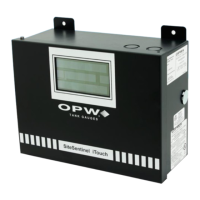4. Program the alarms associated with the lower threshold that you wish to activate if the sensor detects
hydrocarbon liquid.
2
nd
Barrier Position (Hydrocarbon Sensor)
1. Configure the barrier position to be a sensor (or, if using SiteConnect choose the appropriate icon) and
install that position
2. Using the Controller, take a dynamic reading of the hydrocarbon portion of the senor.
3. Set the lower alarm threshold to 0.2 volts lower than the reading taken (this assumes that there is no
current hydrocarbon contamination).
4. Set the upper alarm threshold to 5.0 volts (disables upper threshold).
5. Program the alarms associated with the lower threshold that you wish o activate if the sensor detects
hydrocarbon liquid.
14.1.13 Testing the Float Sensor Portion of the Combo Sensor
Sensor installed in a normally DRY well
• Place the float in the UPPER position. This should trigger an alarm in the Controller.
• Return the float to its lower position. Confirm that the alarm ends in the Controller.
Sensor installed in a normally WET well
• Place the float in the LOWER position. This should trigger an alarm in the Controller.
• Return the float to the upper position and check that the Controller is no longer in alarm.
If the Controller fails to register the alarm condition, check your programmed thresholds in the Controller.
Check the orientation of the float as described on page Error! Bookmark not defined..
Disconnecting the sensor should trigger an alarm and shorting the sensor should be out of alarm. Check all
wiring and junction boxes to ensuring continuity without shorts.
14.1.14 Testing and Decontaminating the Hydrocarbon Sensor Portion of the
Combo Sensor
To prevent the possibility of explosion or fire, do not test the sensor in the
Hazardous Area.
Work in a well-ventilated area with no hot surfaces or open flames.
Do not use fuel to test the sensor!
If the SiteSentinel iTouch Controller fails to detect alarm conditions simulated here, also check that your
Controller thresholds are correct
• Testing the Hydrocarbon Liquid Sump Sensor. Immerse the polymer in mineral spirits for about 10
minutes. Remove the sensor and let it hang to air dry. After another 10 minutes any Controller alarms
or events associated with the hydrocarbon sensor should trigger. Disconnect this portion of the sensor
from the Controller – an immediate alarm should result. Short across these Controller positions – an
alarm should also occur. If the open lead and/or short lead test fail, check all wiring and junction boxes
for continuity.

